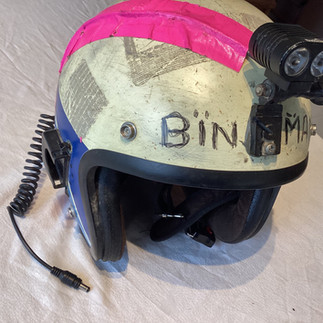
Off-road Motorcycle helmet lighting systems - a comparison. One vs. Two vs. Three LEDs. Headtorch, OxBow, FullOn lights.
- Jonathan Binnington
- 6 days ago
- 10 min read
Updated: 5 days ago
Photo above courtesy of Full On Lights, Victoria BC.
The Dark Nights are upon us! Woe!!
I am investigating lighting solutions for off-road riding in the hours of darkness principally in anticipation of the 24 Heures du GoldRiver next September, but also simply to be able to get out and ride this winter.
As you have come to expect, I am doing a bit of a deeper dive into this subject. The previous blog post I wrote about this introduced the three lighting systems I am comparing and also discussed in a very superficial way the Physics units used to quantify lighting “brightness”.
Very briefly, the SI (metric) unit of “general brightness” is the lumen (Lu). Without getting unnecessarily bogged down, the lumen is a measure of brightness that is calibrated to replicate the sensitivity of human vision to light of different colours.
A 60 Watt bulb produces about 800 lumens.
An aftermarket LED H4 headlight bulb produces about 1080 lumens.
The FENIX single LED headtorch produces 1200 lumens
The two- LED Oxbow light is rated at 2100 lumens at it’s maximum setting
The Full On MB6 three-LED light is rated at a maximum of 6000 lumens
The Canada vehicle construction and use regulations
The regulations that apply to vehicle lighting are contained in this Act, specifically Section 4. (https://www.bclaws.gov.bc.ca/civix/document/id/complete/statreg/26_58_01#section4.24 )
The Act regulates the number, type and position of lights fitted to motor vehicles and the British Columbia Act is a direct write-over of the Federal Canadian Act.
It confusingly speaks of Candelas as the unit of “brightness” as opposed to the lighting industry’s standard unit of Lumen. I have it on good authority that Candela is the unit with which to measure the brightness of a light in a particular direction, whereas Lumen is the unit used to measure the total light emitted by a source.
Consider a tightly focussed spot lamp beam of relatively low power but very small spread versus a high-intensity floodlight with a wide field of illumination. So it may be more appropriate to measure directed light in Candelas (as in beam brightness) rather than Lumens measuring total emitted light - or perhaps not if you are after floodlighting…
So, that is as clear as day then… :~/ NFH!
To add confusion to the muddied waters of vehicle illumination, The Canada Federal and BC version of the above Act and its Federal equivalent are both silent on the matter of lights, lamps and illumination attached to the bodies of riders and drivers, despite going on at length (in Section 4) about lighting attached to vehicles…
One thing the Act is clear about, though, is that the use of H4 LED aftermarket “bulbs” in headlight/reflector units NOT specifically designed for them (eg designed for incandescent tungsten-halogen bulbs) is a no-no. But these replacement bulbs continue to be easily available… and widely used.
The lights under test.
I have three lights to compare, all aftermarket and LED.
FENIX single LED, battery powered headtorch. 1080 Lu.
Oxbow motorcycle, two LED light unit attached to a motorcycle helmet. Powered by the motorcycle electrical system. 2100 Lu (max).
Full On MB6 mountain bike helmet light, three LED. Powered by a pre-prototype power supply wired into the motorcycle electrical system. 6000 Lu (max).
As you can see, the FENIX and Oxbow lights are both well used.
The FENIX is used to light evening dog walks and to illuminate garage work in less than ideal lighting situations.
The Oxbow has been on the front of my open face helmet for years and has been through many hedges forwards, backwards and sideways.
The Full On MB6 is a very recent acquisition.
Both the Oxbow and the Full On lights come with GoPro mounts providing alternatives for helmet mounting. Both helmets shown have factory-fitted M6 metal bushes bonded into the helmet shell. These have been used to effect bolt-on fittings using short M6 screws. Should a helmet not have such factory-fitted parts, I have also included a strap-on chin mount for a GoPro which would also appropriately allow a secure mount.
Test Methods.
Preliminary experimentation has shown that the sensitivity of smartphone cameras in low light conditions is greater than the human eyes for visualisation. It is difficult to capture images that realistically demonstrate real-life illumination provided by the light systems under test.
Additionally, scientific instrumentation required to measure illumination and verify emitted light from the test units is unavailable to common-or-garden motorcycle enthusiasts.
Instead, the comparative measure used is the subjective experience of “night time motorcycling illumination”. The age old seat-of-the-pants reactions.
I have also invited one of my riding colleagues to take night-time rides on the test bike (my DR650) and to give his reactions to each of the lights, used in conjunction with the bike’s headlights were recorded.
Declaration of interests.
I bought both the FENIX and Oxbow lights a number of years ago and both have seen much use. The Full On MB6 light was supplied to me by the retailer/supplier (Full On Lighting Ltd, 140 - 2930 Amy Rd, Victoria BC. See www.fullonlighting.com ). I bought the electrical components to build the prototype 12v power supply.
Full list of power supply prototype parts.
Electrical connectors. Spade terminals, loop end terminals, solder, block connectors to match the wiring loom, electrical wire and insulating tape, heat shrink tube.
In-line fuse holder, 10A fuse.
Solenoid power relay.
12V to 20V DC voltage converter (shown below).
5mm, two terminal power jack plug.
USB-c female to female connector.
Chin GoPro mount.
Full On MB6 Power supply prototype.
The MB6 as supplied is intended for use by the mountain bike community. It is supplied with a battery unit that cunningly disguises the substantial amount of tech contained.

To explain, the MB6 runs on voltages up to 20 volts, a far higher voltage than LEDs usually run off (5V or 12V). In order to be able to supply up to 20V from the motorcycle electrical system (nominally 12V), it is necessary to use a DC voltage transducer - not a transformer in the AC voltage manner but a electronic device capable of stepping 12V up to 20V. The transducer used in the pre-prototype is a SHNITPWR 100W usb-c converter. Motorcycle power in is 12V from the battery, through a fused power relay triggered from a switched live from the bike’s ignition switch.

At this point it is important to explain the very small amount of understanding I have about usb-c and how this is much more complicated than you think it is….
At first there was “dumb usb-c”. It ran on 5V and was just a wire. Then came usb-c 2.0 and after it a whole load of other variations that on the outside look like a fat wire with a space-age connector. But higher-spec end devices make use of the high functions capable with usb-c. There is (can be) a two way communication between the power supply and the end-device as the needs of the light (in our case) are communicated to the power supply. This is called the “usb-c handshake”. There is an initial supply of 5V, then the light talks to the power supply and says 10V, 15V or 20V (or whatever) please! The power supply then steps its game up and away it goes (kinda….).
Which is why the Full On battery is as special as it is. There is much going on under that charcoal grey rubber surface!
The battery duration with the light at full power is two hours, as stated by the suppliers. While a two hour mountain bike ride would be long enough for all but the most committed cyclists, motorcyclists would only just be getting into their stride after a couple of hours - so an alternative power supply solution is needed. I had already been pointed in the direction of the DC volts to DC volts transducer (above), so the circuitry needed to switch and power the transducer was assembled according to the circuit diagram (below).

If you have wired USB phone chargers into your bike, you will be able to do this. I am not going to give you a blow-by-blow account of how to do this - a certain amount of knowledge and skill is assumed.
And. It. Works!

A very busy photo from the depths of my garage, but you can see the voltage transducer zip tied to the brake hose and the usb-c female to female connector joining up to the light cable.
The hidden benefit of the usb-c connector is that it provides a secure connection while also providing a low physical resistance break joining the rider to the bike.
The complete “kit of parts” for the power supply: I am sure you can buy equivalent components more cheaply if you shop around. Also, I have not included miscellaneous items such as spade connectors, various short lengths of wires, solder, blah blah blah…
So, how well does it work and is there a noticeable difference between the 2LED and the 3LED units???
In order to make subjective comparisons, a riding friend was recruited to test the two sets of helmet-mounted lights, one after the other.
My observations are as follows:
Fenix - Single LED. Rechargeable battery. Max brightness setting.
The Fenix headtorch has a quite tightly focussed central beam that maximises the brightness of the centrally illuminated patch. The less-brightly illuminated outer pool is probably no wider than a 60 degree cone which, for walking/running/cycling/fixing the bike in the dark is perfectly adequate. Given the Fenix is powered by a rechargeable battery and its battery life on full beam is not more than three hours, it isn’t a good proposition for additional motorcycle lighting - but it is included here to provide a benchmark.
If you want to have a “camp light” for use when not riding, it is good - especially when stepped down in intensity.
Oxbow - Twin LED helmet light, powered from the bike electrical system, sold by Oxbow. Tested at maximum intensity.
I fitted this light system to my bike and helmet a few years ago. Despite my indifference to maintaining the electrical and lighting system it continues to work! When comparing the Oxbow to the Fenix, the Oxbow demonstrates its greater performance. The lighting performance of the Oxbow is better than the bike’s headlight alone (no shit, Sherlock…!). The peripheral lighting isn’t spectacular, but the natural vision scanning activity of motorcyclists, moving the head to look in the direction of interest easily overcomes any shortcomings of peripheral vision lighting. Probably illuminates 100m up the road.
The Oxbow does what it says on the box.
Full On MB6 - Three Led helmet light, powered from the bike’s electrical system. Also tested at maximum intensity.
Floodlights!
Bright. Wide beam. Long range (300-400m). You could play a game of football under this light! The Beautiful Game….
This light, on full beam is probably too bright (way too bright) for on-road use. Oncoming drivers would be temporarily visually impaired after being beamed out. Off road though, with no oncoming traffic, the MB6 illuminates the dark desert highway so well that the road is as visible as it is in daylight - at least for the rider. If you are in front of a rider with a Full On MB6, the shadow you cast will be deep and dark, unless, that is you also have a MB6 on full-tilt…
Stuart O, VIME staffer in his own words:
The Oxbox does the job. It makes a noticeable difference…
(Then with typical English understatement) he goes on to say:
The Full On MB6, I say! That is good!! It fills in all the dark pools the Oxbox left. Especially good when mounted on the helmet rather than the handlebars.
You probably wouldn’t need to run it at full power all the time - except perhaps in extreme circumstances.
It makes the headlight (of the bike) irrelevant! It lights up where you look - I’m going to have to get myself one of those…
The KTM 250 EXCF has an alternator rated at 196Watts, enough to drive a MB6.
“But I would say it’s biggest limitation is having to fiddle around on top of your head to make any changes to the brightness whilst on the move. Or to switch it back on if you turn it off or it goes off for whatever reason. A bar mounted controller would be much safer.
(The Oxbow light is also controlled in the same way with a button on the light body)
“The full brightness is nice but I think unecessary and I do wonder if in a group might be a problem casting shadows like I described with night mountain bike riding .”
(Is there a mountain bike etiquette for night riding with lights?)
“The etiquette is don’t be a dick.
Bar mounted lights are easier to control. Head mounted lights became more popular but the light control was always annoying, having to fiddle on the move with a light on your head. The headlights used to be a much more focussed spot on the head, and a flood on the bars. Not the near nuclear white out of 6k lumens on the head. Which gives such a bright flood that there is no need for a spot element.”
(A fairly pragmatic etiquette then….?)
In conclusion.
These three lights represent the evolutionary development of lighting for outdoors physical activity.
The FENIX head torch is a torch (North American : flashlight) for your head. It is light in weight, convenient to use and inexpensive. Once you try to use it as an extra light for riding motorcycles you have probably exceeded its capabilities though. Like I said, I have included it here in this test to give a benchmark against which the other lights can be compared.
The Oxbow (as tested) is probably a double FENIX with the advantage of being powered from the motorcycle’s electrical system. Alone, it is probably better than the headlight on my bike and when used in conjunction with the bikes’s headlights the illumination good enough for night-time gravel road riding. Limitations of the beam spread can be overcome by turning your head to point the beam in the direction you wish to look in, which is a natural action for motorcyclists accustomed to scanning the road for upcoming hazards.
The Full On MB6 with prototype wired-in power supply is easily the best light of these three. It’s beam is bright, wide, far-reaching. It’s light is far more powerful than any motorcycle headlight I have used and when stepped down in intensity, it is much more than a riding floodlight. If you are going to do any off road riding at night, this is the light that will outperform the others.
For me, it is a very easy choice to make. The MB6.
Citations:
Motor Vehicle Act Regulations
Full On Lighting
#140, 2930 Amy Road
Victoria, BC V9B0B2




































Comments